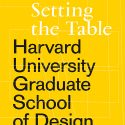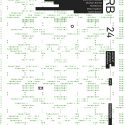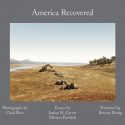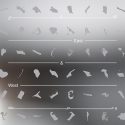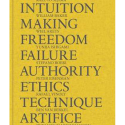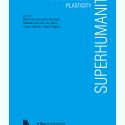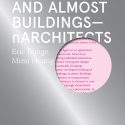GSD Platform 10: Live Feed
GSD Platform 11: Setting the Table
Imminent Commons: Live from Seoul
The fourth book from the Seoul Biennale 2017 explores the sites, exhibition installations, and diverse array of programs that were realized during the Seoul Biennale. Imminent Commons: Live from Seoul is Centered on the Live Projects sections (Production City, Urban Foodshed, Walking the Commons) and the Public Programs, the book highlights Seoul's complex urban fabric as a theatre on which the Seoul Biennale was played out. It is a book that focuses less on individual installations and more on the biennale as a specific set of places. It shows how much the character of theses places is an integral part of the Biennale's cosmopolitan, transnational gaze. The book includes essays by Hyungmin Pai, Hyewon Lee, Yerin Kang and Jie-Eun Hwang, Soo-in Yang and Kyungjae Kim, Soik Jung, E-Roon Kang and Wonyoung So, Won-joon Choi, John Hong, Kyubg Yong Lim, Sunjae Kim, Nayeon Kim, Dongwoo Yim and Calvin Chua, OBRA Architects, with photographs by Kyung Sub Shin and Suyeon Yun.
KERB 24
Louella Exton, Kim Morte, Hayden Matthys, Millicent Gunner, Emma Groot
Kerb Journal is a 24 year running, produced by the Landscape Architecture program of RMIT University. 2016 sees Kerb24 focus on the thematic of Territory and its place in the discourse of Landscape Architecture and the broader design industry. Territories start off as nonphysical, often simple ideas, emerging in the physical and becoming a perpetual mixture of the two. Often formed to acquire resources, yet inherently a resource. Land is seized for economic gain, borders are traversed through changes to regulations, and new territories of control are born from land reclamation where previously none existed. Imposing order and control over landscapes in varying states of flux. Conflict often leads to territories shifting or being taken by force. Yet as often as the former, unions of territories can proliferate through consensus and peaceful treaties. They can be rigid or malleable and perceptions of territories can differ for individuals compared to a group of people aligned in thought. Territory can be a landscape of blurred and invisible boundaries, overlapping in time and space. All these assertions lead us to questions. To create a territory, must one first understand it? What becomes possible when we start to question what territory is? How can it link-up with other disciplines?America Recovered
Chad Ress, Jordan H. Carver, Miriam Paeslack
America Recovered reveals the point where abstract political processes manifest themselves in the physical world, thus providing an alternate means of experiencing the contemporary American landscape. Collectively, the images and essays show what aspects of our everyday lives are being assigned value in the promise of a recovered America. In 2009 President Obama signed the American Recovery and Reinvestment Act known as the stimulus bill. Along with the bill, the administration launched Recovery.gov , a website to foster greater accountability and transparency in the use of covered funds. America Recovered collects forty images that mark one of the only efforts to document the breadth of projects funded by the 2009 American Recovery and Reinvestment Act. Unlike the New Deal and other programs designed for employment and infrastructural development, the Recovery Act was passed without any funds dedicated for photographic documentation. Using an official government website as his guide, Chad Ress took photographs of projects across the country. The publication of America Recovered at this moment allows for a critical reassessment of the Act and its lasting impact on the American landscape. The two essays by architectural writer Jordan H. Carver and photography historian Miriam Paeslack situate Ress's photographs within broader discourses of urbanism, infrastructure, and politics. The question of what role the government should play in everyday life remains one of the touchstone issues in American politics. The photographs and essays ask a different set of questions, not whether government spending is good or bad, whether it worked or didn't, but what, exactly does government spending look like. And importantly, America Recovered asks how government spending and civic identity are constructed around place.
EBOOK EDITIONBetween East and West: A Gulf
Hamed Bukhamseen & Ali Karimi / Civil Architecture
Between East and West: A Gulf looks towards the contested hydrography of the Arabian/Persian Gulf and proposes a new masterplan for the region. In an area of physical, religious, and political division, the publication tells the story of the Gulf's islands and the possibilities they hold for a joint territorial project. Hundreds of islands dot the waters between the Arabian and Persian shores. An afterthought in the political maneuverings of their respective coasts, tell an alternative narrative to the one which drives conceptions of the region. They represent a possibility greater than spaces of political contestation and hesitant demarcation. These islands are the sites of identity in formation, places of experimentation and architectural invention. Their historical roles were as varied as places of leisure, spirituality, planning, war, exile, and health.
The book was an accompaniment to the third Kuwaiti participation at the 15th International Architecture Exhibition La Biennale di Venezia 2016 with a pavilion that shares the same title.
Crown Hall Dean’s Dialogues 2012-2017
Superhumanity
Post-Labor, Psychopathology, Plasticity Chin Jungkown, Common Accounts (Igor Bragado & Miles Gertler), Arisa Ema, Hong Sungook, Yuk Hui, Kim Jaehee, Catherine Malabou, Hannah Proctor, Erik Rietveld, Mark Wasiuta
The field of design has radically expanded. As a practice, design is no longer limited to the world of material objects, but rather extends from carefully crafted individual looks and online identities, to the surrounding galaxies of personal devices, new materials, interfaces, networks, systems, infrastructures, data, chemicals, organisms, and genetic codes.Focused on post-labor, psychopathology, and plasticity of human mind and body, Museum of Modern and Contemporary Art in Seoul, Korea, MMCA, organized a Superhumanity symposium in Korea, consisting of lectures and panel discussions by experts from diverse disciplines, ranging from design and architecture to science, media, history, philosophy, and contemporary art. This book introduces essays by these experts, whose insightful presentations and followed conversations are resonated as a compilation. Faced with the fourth industrial revolution, this book shed light on the necessity to recognize that manmade, artificial objects are continuously reshaping our daily lives, and thus to rethink the intimate and fundamental relationship between design and what it means to be human.
With Contributions of Nick Axel, Beatriz Colomina, Nikolaus Hirsch, Jihoi Lee, Mark Wigley, Chin Jungkown, EBOOK EDITION


